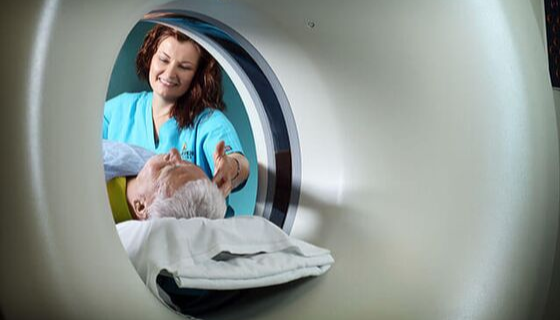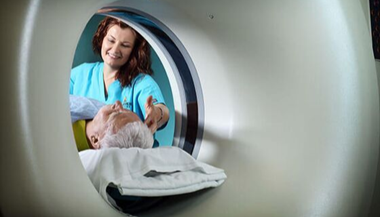Brain Perfusion Scan
What is a brain perfusion scan?
A brain perfusion scan is a type of brain test that shows the amount of blood taken up in certain areas of your brain. This can provide information on how your brain is functioning. There are several different types of brain perfusion scans. Some tests, such as a single photon emission computed tomography (SPECT) or a positron emission (PET) scan, use radiotracers, which are radioactive substances that emit tiny particles. Other tests, such as the computed tomography (CT) perfusion or magnetic resonance imaging (MRI) perfusion, do not use radiotracers.
The areas of the brain that are very active often show greater blood supply as well as greater oxygen and glucose use. Tracking these increases can show which areas of your brain are most active. These factors might be lower in areas of the brain that are injured or not highly active.
During a brain perfusion scan using a radiotracer, your healthcare provider will inject a radiotracer into a vein in your arm. (In other cases, you might inhale the radiotracer in the form of a gas.) Your provider will then use a special camera to detect the tiny radioactive particles emitted by the radiotracer. The camera can track how the radioactive substance spreads throughout your brain. The brain perfusion scan can show which areas of your brain received most of this radioactive substance. This lets your provider know which areas of your brain were the most active during your scan.
Providers often superimpose brain perfusion images with other types of standard imaging tests, such as a computed tomography (CT) scan. This allows them to compare the information from both techniques on one single image.
Some types of brain perfusion scans, such as MRI perfusion or CT perfusion, don’t need a radiotracer. They use a nonradioactive substance that the cells of the body take in. The CT scan takes X-ray pictures over time as the body takes up more and more of this substance. This also gives an idea of the areas of the brain that got the most blood.
Why might I need a brain perfusion scan?
You might need a brain perfusion scan if your healthcare provider needs information about how the blood is flowing in your brain. For example, your healthcare provider may recommend a brain perfusion scan if you have one of the following conditions:
- Epilepsy
- Dementia
- Stroke or transient ischemic attack
- Subarachnoid hemorrhage
- Carotid stenosis
- Cerebral vasculitis
- Brain tumor
- Recent head injury
You also might need a brain perfusion scan if you need an operation on one of the vessels in your brain or neck and your healthcare provider wants to examine the flow of blood through your brain.
Your healthcare provider may also recommend other tests, such as a carotid ultrasound, a CT angiogram, a magnetic resonance angiogram, or an angiogram.
What are the risks of a brain perfusion scan?
Most people don’t have any trouble with their brain perfusion scan. Possible risks include allergic reactions to substances used in the injection or slight pain at the injection site.
Some brain perfusion scans (such as SPECT, PET, and CT) also expose you to radiation. In high doses, radiation is quite dangerous and increases your lifetime risk of cancer, but these studies only use a small amount of radiation. Your healthcare provider will only recommend these brain perfusion scans if your risks from not getting the test are greater than the risks of the test itself. MRI perfusion, however, does not involve radiation or radiotracers.
Talk to your healthcare provider about the possible risks of your brain perfusion scan. Your risks may vary according to your medical conditions, the reason for your scan, and the exact type of brain perfusion scan you receive.
How do I get ready for a brain perfusion scan?
Let your healthcare provider know about all the medicines you are taking. Take all these medicines as you normally would, unless your healthcare provider tells you otherwise. Let your healthcare provider know about any changes in your medical condition, such as a recent fever.
If you are pregnant or think you might be pregnant, tell your healthcare provider. It might make sense to delay your test, because the radiation may pose a risk to your unborn child. Also, let your healthcare provider know if you are breastfeeding. An MRI, however, does not have any major known risks for women who are pregnant or breastfeeding.
Before your exam, you’ll need to remove any metal objects, like hairpins or glasses. Ask your healthcare provider if you need to have your exam on an empty stomach.
Your healthcare provider will provide further instructions based on the specific type of brain perfusion scan you’ll be receiving.
What happens during a brain perfusion scan?
The details of your brain perfusion scan may differ according to the nature of your scan. Your healthcare provider can let you know what your scan will be like. The following is an overview of what you might expect:
- You will lie down on the exam table.
- In some cases, a technician or nurse will insert an IV into a vein in your hand or arm, which might be slightly painful.
- A healthcare professional will give you the tracer, either by IV, by mouth, or by inhalation.
- It may take an hour or so for the tracer to travel through your body. You’ll rest quietly during this time.
- You may need to drink a contrast material for certain kinds of studies.
- You’ll move into the scanner for your imaging. This is a small space that some people find claustrophobic. It’s important that you remain very still during this time. This will not hurt.
- You might have one or more different scans while you are inside the scanner.
What happens after a brain perfusion scan?
Often, a brain perfusion scan takes place as an outpatient procedure, which means you’ll be able to go home soon after your scan. Other times, hospitalized patients receive brain perfusion scans. If you had an IV line, someone will remove it unless you need it for another medical problem.
Most people can resume normal activities right after their brain perfusion scan. Your healthcare provider will let you know if you need to take any special precautions.
The small amount of tracer in your body will quickly lose its radioactivity, and your body will soon remove it through your urine and feces. Drink plenty of water in the hours and day after the test. This will help flush out the remaining radioactive tracer in your body.
A radiologist will read and interpret your exam and will send these results to your healthcare provider. Ask your healthcare provider about when you can expect to learn the outcome of your scan. You and your healthcare provider can use the results to help formulate your treatment plan.
Next steps
Before you agree to the test or the procedure make sure you know:
- The name of the test or procedure
- The reason you are having the test or procedure
- What results to expect and what they mean
- The risks and benefits of the test or procedure
- What the possible side effects or complications are
- When and where you are to have the test or procedure
- Who will do the test or procedure and what that person’s qualifications are
- What would happen if you did not have the test or procedure
- Any alternative tests or procedures to think about
- When and how will you get the results
- Who to call after the test or procedure if you have questions or problems
- How much will you have to pay for the test or procedure





